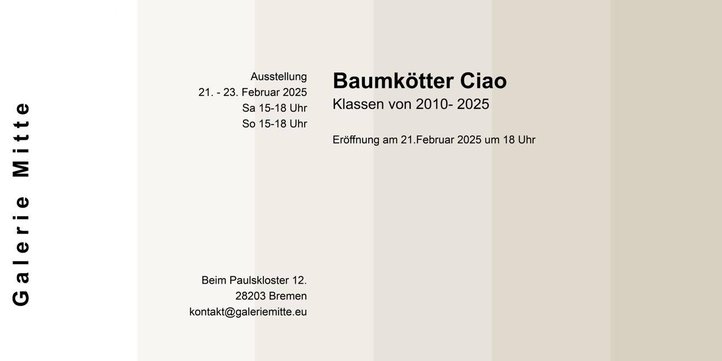To mark Stephan Baumkötter's retirement after many years as professor of painting at the Hochschule für Künste (HfK) Bremen, Galerie Mitte, Beim Paulskloster 12, invites you to the exhibition “Baumkötter Ciao (Klassen 2010 - 2025)”.
Students from the last 15 years have come together to present their work as a “state of affairs” - works from different phases of their artistic development, in which Stephan Baumkötter's teaching plays an interface between the works.
Exhibition opening: 21.2.2025, 6 pm.
Opening hours: 22/23.2.2025, 3 pm to 6 pm each day.
Participating artists: Carleen Dawn Albrecht, Kate Andrews, Ryosuke Aratani, Anna Bart, Andreas Becker, Ulises Gaspar Bimmermann, Karina Burjakov, Florentine Christiansen, Sebastian Dannenberg, Marei Dierßen, Alice Gericke, Christiane Gruber, Vincent Haynes, Tobias Heine, Qi Jin, Emese Kazár, Paul Kiesow, Karolina Koßmann, Elard Lukaczik, Atsushi Mannami, Harumi Miyato, Silke Parras, Laura Pientka, Arne Rose, Simon Schadwinkel, Malte Stiehl, Jana Thiel, Francisco Valença Vaz, Armin Wischkony, Florian Witt and Daniel Wrede.
HfK alumnus Francisco Valença Vaz bidding farewell to Stefan Baumkötter:
After fifteen years of professorship, one leaves behind a legacy that consists of various forms of a practice and can be located in the work of other artists. In my memory, this begins with his own words: “Painting is the application of color to a surface, and this registers what another body draws on it.”
We visited Stephan Baumkötter in his Cologne studio in 2016. Many canvases, mostly no larger than half a square meter. No square works, but vertical format paintings. With the ignorance of a first semester student, I thought they were all the same. At that time, I wanted to see colorful pictures, à la Albert Oehlen, whose work I was later to understand as the antithesis of Stephan Baumkötter's aesthetic thinking... But over time I realized that his paintings vary in tone and structure. They are a kind of register, not painted, and yet: he drew physical gestures with oil crayons until no gesture could be seen, but still remained on the canvas. Invisible and yet present, this principle can be transferred as an anecdote for his teaching. A trace that does not remain in perception, but is inscribed in materiality. In The Insistent Heart, Jean-Luc Nancy describes how a gesture never simply remains a gesture, but always touches something else: another physicality, another being. A trace is never static, but always a movement, a continuation. Baumkötter's principle can also be applied to his students. They develop very different methods and strategies in dealing with materiality, but from a similar starting point. This point could be the confrontation with what one sees and also the realization that what one wants cannot always be found in the materiality. A kind of dialog in which the indexicality of the object constantly opens up new levels of meaning. And that is a challenge: how can a doctrine be developed that does not retreat to a simplified definition of form and meaning, that does not simply depict or record? By removing all possible representations from recognizability, his work possibly creates a kind of radical entropy: one that does not dissolve into chaos, but remains in the space between the visible and the invisible. Perhaps you can get an idea of how he taught if you imagine how he himself begins a picture, possibly without a preliminary drawing, without a sketch or plan. Every decision follows the first line or the first stroke that he puts on the canvas. And even if these are no longer visible later, they are there, influencing the sequence and shaping the picture. Each experience builds on another. In this way, without a plan, he approaches each of his students' problems with different strategies, and it is only in this way, as in the exhibition, that different working methods emerge that can still be traced back to his covered gestures. They reflect different semantics of his work, not as a repetition, but as a possible continuation of the questions that are anchored in his practice. Like a heartbeat that is constantly moving between setting and withdrawing, and between visibility and withdrawal.
